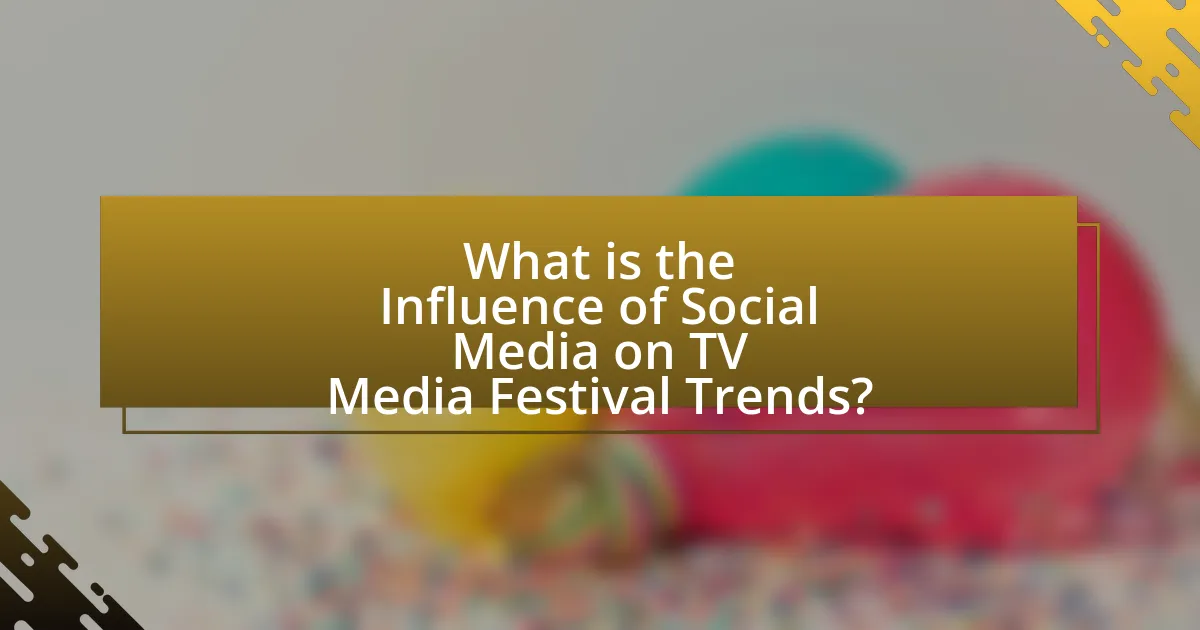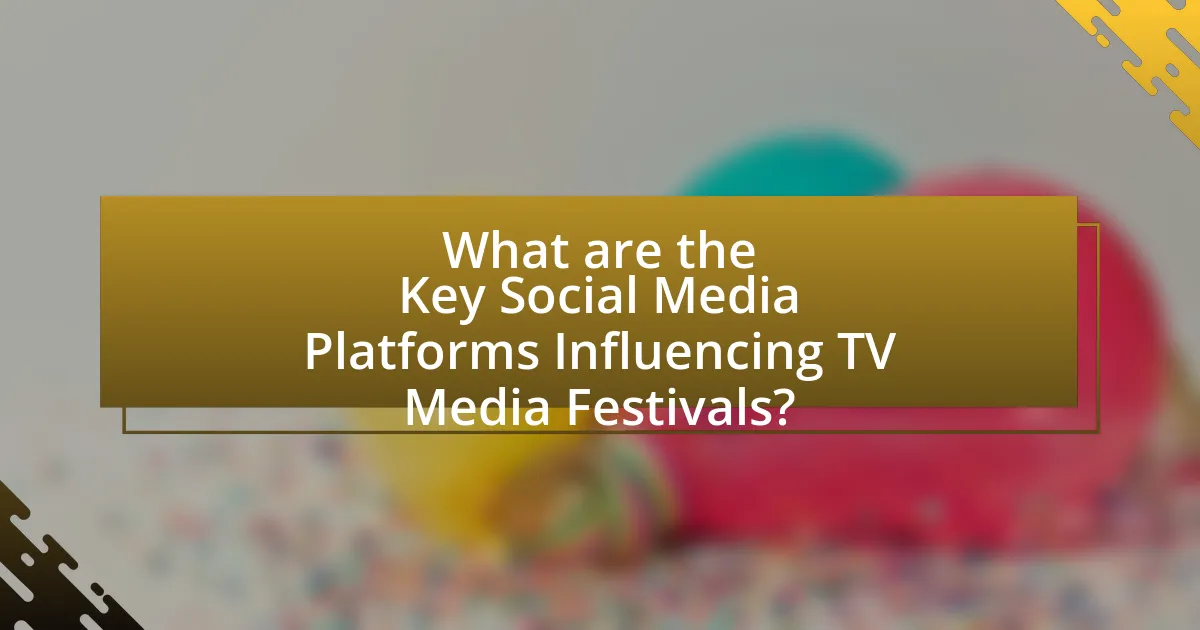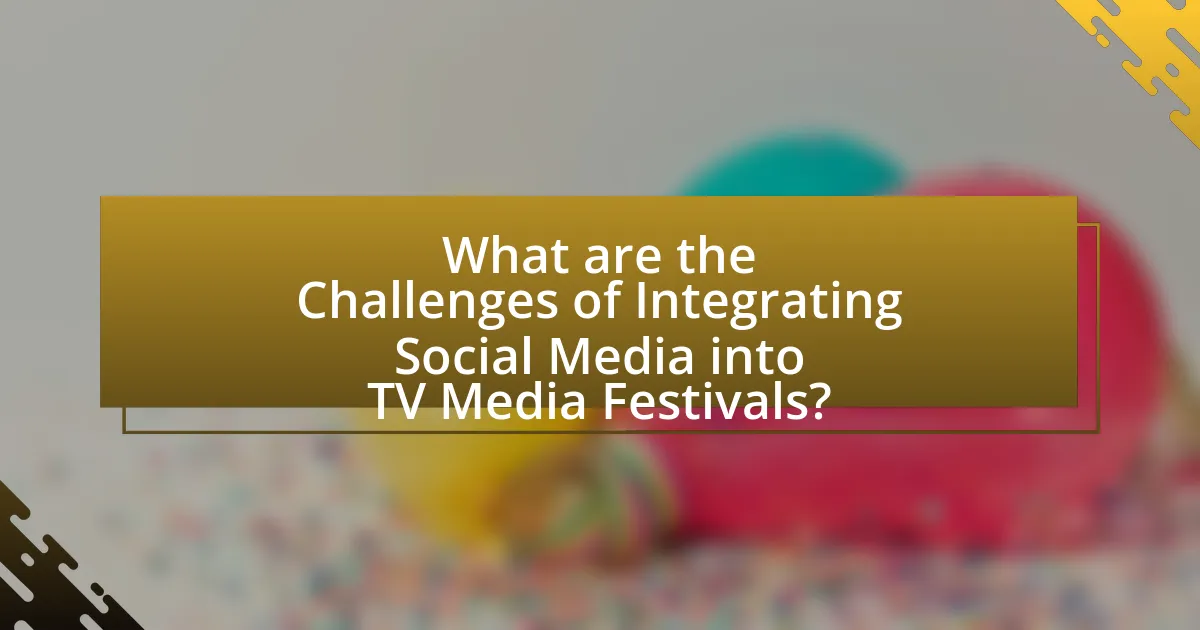The article analyzes the influence of social media on TV media festival trends, highlighting how platforms like Twitter, Instagram, and TikTok enhance audience engagement and content promotion. It discusses the transformation of festival dynamics through real-time interactions, increased visibility, and the emergence of specific trends such as user-generated content and targeted marketing strategies. Additionally, the article examines the challenges of integrating social media into festivals, including managing audience expectations and ensuring content authenticity, while providing insights into effective practices for leveraging social media to boost attendance and participant satisfaction.

What is the Influence of Social Media on TV Media Festival Trends?
Social media significantly influences TV media festival trends by shaping audience engagement and content promotion. Platforms like Twitter, Instagram, and TikTok allow real-time interaction, enabling fans to discuss and share their experiences, which amplifies visibility for festivals. For instance, a study by the Pew Research Center found that 69% of adults in the U.S. use social media, indicating a vast audience that can be reached through these channels. Additionally, festivals often leverage social media for marketing, utilizing hashtags and influencer partnerships to create buzz and attract attendees, as seen with events like the Sundance Film Festival, which has successfully used social media campaigns to enhance participation and viewership.
How has social media changed the landscape of TV media festivals?
Social media has significantly transformed the landscape of TV media festivals by enhancing audience engagement and expanding reach. Platforms like Twitter, Instagram, and Facebook allow festivals to promote events in real-time, facilitating direct interaction between creators and fans. For instance, the 2021 Sundance Film Festival utilized social media to host virtual screenings and discussions, reaching over 1.1 million viewers globally, compared to previous years where attendance was limited to physical locations. This shift not only democratizes access to content but also enables festivals to gather immediate feedback and foster community discussions, thereby reshaping traditional festival dynamics.
What specific trends have emerged in TV media festivals due to social media?
Social media has led to several specific trends in TV media festivals, including increased audience engagement, real-time feedback, and enhanced promotional strategies. Audience engagement has surged as platforms like Twitter and Instagram allow fans to interact with creators and participate in discussions during events, exemplified by the use of hashtags to facilitate conversations. Real-time feedback is evident as viewers share their opinions instantly, influencing how content is perceived and discussed, which was notably observed during the 2021 Emmy Awards when social media reactions shaped the narrative around winners. Additionally, promotional strategies have evolved, with festivals leveraging social media for targeted marketing campaigns, as seen in the Cannes Film Festival’s use of Instagram to showcase behind-the-scenes content and attract a younger demographic. These trends illustrate the profound impact of social media on the dynamics of TV media festivals.
How do social media platforms shape audience engagement at these festivals?
Social media platforms significantly shape audience engagement at festivals by facilitating real-time interaction and content sharing among attendees. These platforms enable users to post updates, share experiences, and connect with others, creating a sense of community and enhancing the overall festival experience. For instance, a study by the Pew Research Center found that 69% of adults in the U.S. use social media, which indicates a broad audience reach and potential for engagement during events. Additionally, festivals often leverage hashtags and live streaming features on platforms like Twitter and Instagram to encourage participation and amplify visibility, leading to increased audience involvement and interaction.
Why is it important to analyze this influence?
Analyzing the influence of social media on TV media festival trends is important because it reveals how audience engagement and content consumption patterns are shifting. Social media platforms have become primary channels for audience interaction, impacting viewership and promotional strategies for festivals. For instance, a study by the Pew Research Center found that 69% of adults in the U.S. use social media, which indicates a significant potential for these platforms to shape public perception and trends in media festivals. Understanding this influence allows stakeholders to adapt their strategies, enhance audience reach, and improve overall festival experiences.
What insights can be gained from understanding social media’s impact on TV media festivals?
Understanding social media’s impact on TV media festivals reveals how audience engagement and content promotion have evolved. Social media platforms facilitate real-time interaction, allowing fans to share experiences and opinions, which can significantly enhance the visibility and reach of festivals. For instance, a study by the Pew Research Center found that 69% of adults in the U.S. use social media, indicating a vast audience that can be tapped for promotional purposes. Additionally, social media analytics provide insights into viewer preferences and trends, enabling organizers to tailor content and marketing strategies effectively. This data-driven approach can lead to increased attendance and participation, demonstrating the critical role social media plays in shaping the success of TV media festivals.
How does this analysis benefit festival organizers and participants?
This analysis benefits festival organizers and participants by providing insights into audience engagement and preferences shaped by social media interactions. Festival organizers can leverage this data to tailor programming, marketing strategies, and enhance attendee experiences, ultimately leading to increased attendance and satisfaction. For instance, understanding trending topics on social media allows organizers to curate relevant content and attract a larger audience. Participants benefit from a more personalized festival experience, as their preferences are considered in the planning process, fostering a sense of community and connection.

What are the Key Social Media Platforms Influencing TV Media Festivals?
The key social media platforms influencing TV media festivals are Twitter, Instagram, and Facebook. Twitter serves as a real-time communication tool, allowing users to engage in live discussions and share updates during festivals, which enhances audience interaction and visibility. Instagram is pivotal for visual storytelling, enabling festivals to showcase highlights, behind-the-scenes content, and promotional material through images and videos, thus attracting a younger demographic. Facebook facilitates community building and event promotion, allowing users to create event pages, share experiences, and connect with other attendees, which increases overall engagement and participation. These platforms collectively shape the narrative and reach of TV media festivals, as evidenced by their widespread use for event promotion and audience engagement strategies.
Which platforms are most commonly used for promoting TV media festivals?
The most commonly used platforms for promoting TV media festivals are social media networks, particularly Facebook, Twitter, Instagram, and LinkedIn. These platforms enable festival organizers to reach a broad audience, engage with potential attendees, and share updates in real-time. For instance, Facebook allows for event creation and targeted advertising, while Instagram’s visual content is effective for showcasing festival highlights. According to a study by the Pew Research Center, as of 2021, 69% of adults in the U.S. use Facebook, making it a key platform for event promotion. Additionally, Twitter’s fast-paced environment facilitates immediate interaction and updates, which is crucial during festival events.
How do different platforms cater to various audience demographics?
Different platforms cater to various audience demographics by tailoring content, features, and advertising strategies to meet the preferences and behaviors of specific user groups. For instance, platforms like Instagram and TikTok primarily attract younger audiences through visually engaging content and short-form videos, while Facebook appeals to a broader age range by offering diverse content types and community features. Additionally, LinkedIn targets professionals by focusing on career-related content and networking opportunities. According to a Pew Research Center study, 71% of teens use Instagram, highlighting its effectiveness in reaching younger demographics, whereas 60% of adults aged 30-49 use Facebook, demonstrating its appeal to a more mature audience. These targeted approaches ensure that platforms effectively engage their respective user bases.
What unique features of these platforms enhance festival visibility?
Social media platforms enhance festival visibility through features like targeted advertising, user-generated content, and real-time engagement. Targeted advertising allows festivals to reach specific demographics, increasing attendance and awareness; for instance, Facebook’s ad targeting can focus on users’ interests and locations. User-generated content, such as posts, photos, and videos shared by attendees, creates organic buzz and authentic promotion, as seen with festivals like Coachella, where attendee posts significantly amplify visibility. Real-time engagement features, such as live streaming and interactive stories, enable festivals to connect with audiences instantly, fostering a sense of community and encouraging participation. These features collectively contribute to a festival’s visibility by leveraging the vast reach and interactive nature of social media.
How do social media campaigns affect festival attendance and participation?
Social media campaigns significantly enhance festival attendance and participation by increasing visibility and engagement among potential attendees. Research indicates that festivals utilizing targeted social media advertising experience a 30% increase in ticket sales compared to those that do not engage in such campaigns. Additionally, social media platforms facilitate real-time interaction, allowing organizers to create buzz and foster community among attendees, which further drives participation. For instance, a study by the Event Marketing Institute found that 74% of event attendees are influenced by social media posts when deciding to attend a festival. This demonstrates that effective social media strategies can directly correlate with higher attendance rates and greater participant involvement.
What strategies are effective in leveraging social media for festival promotion?
Effective strategies for leveraging social media for festival promotion include targeted advertising, influencer partnerships, and engaging content creation. Targeted advertising allows festival organizers to reach specific demographics, increasing ticket sales and attendance; for instance, Facebook Ads can be tailored to users based on interests and location. Influencer partnerships enhance credibility and expand reach, as influencers can share festival experiences with their followers, driving interest and engagement. Engaging content creation, such as behind-the-scenes videos, live streams, and interactive posts, fosters community involvement and excitement, which can lead to higher participation rates. According to a study by Eventbrite, 80% of event organizers believe social media is crucial for promoting their events, highlighting its effectiveness in reaching potential attendees.
How can user-generated content impact festival success?
User-generated content significantly impacts festival success by enhancing audience engagement and increasing visibility. When festival attendees share their experiences through photos, videos, and reviews on social media platforms, they create authentic narratives that resonate with potential attendees. According to a study by the Event Marketing Institute, 84% of millennials say user-generated content from friends influences their purchasing decisions, highlighting the persuasive power of such content. Additionally, festivals that actively encourage and showcase user-generated content often see higher ticket sales and stronger community connections, as this content fosters a sense of belonging and excitement among participants.

What are the Challenges of Integrating Social Media into TV Media Festivals?
The challenges of integrating social media into TV media festivals include managing diverse audience expectations, ensuring content authenticity, and addressing technical issues. Diverse audience expectations arise as social media platforms attract varied demographics, leading to conflicting preferences for content and engagement styles. Ensuring content authenticity is crucial, as the rapid dissemination of information on social media can lead to misinformation or misrepresentation of festival events. Technical issues, such as connectivity problems and platform compatibility, can hinder real-time engagement and content sharing during festivals. These challenges necessitate careful planning and strategy to effectively leverage social media’s potential while mitigating its drawbacks.
What potential pitfalls should organizers be aware of?
Organizers should be aware of the potential pitfalls of mismanaging social media engagement, which can lead to negative public perception and decreased attendance. Poorly handled social media interactions, such as ignoring negative feedback or failing to respond to inquiries, can damage the festival’s reputation. Additionally, over-reliance on social media for promotion without a balanced marketing strategy may result in reaching a limited audience, as not all demographics engage with social media platforms equally. Research indicates that 70% of consumers are influenced by online reviews, highlighting the importance of maintaining a positive social media presence to attract attendees.
How can negative social media interactions affect festival reputation?
Negative social media interactions can significantly harm a festival’s reputation by amplifying negative perceptions and experiences among potential attendees. When users share unfavorable opinions or experiences online, these interactions can quickly spread, influencing public sentiment and discouraging attendance. For instance, a study by the Pew Research Center found that 64% of people are influenced by social media when deciding whether to attend events, indicating that negative posts can deter potential festival-goers. Additionally, negative interactions can lead to a decline in ticket sales, reduced sponsorship opportunities, and a tarnished brand image, as seen in cases where festivals faced backlash over poor organization or safety issues highlighted on social media platforms.
What measures can be taken to mitigate these risks?
To mitigate the risks associated with the influence of social media on TV media festival trends, organizations can implement comprehensive social media policies and guidelines. These policies should include clear protocols for content sharing, audience engagement, and crisis management to prevent misinformation and negative publicity. Research indicates that 70% of organizations that actively manage their social media presence report a decrease in reputational risks. Additionally, training staff on social media best practices can enhance their ability to navigate potential pitfalls effectively. By establishing these measures, organizations can safeguard their reputation and maintain a positive relationship with their audience.
How can organizers effectively manage social media during festivals?
Organizers can effectively manage social media during festivals by implementing a strategic content plan that includes real-time updates, audience engagement, and targeted advertising. A well-defined content calendar allows organizers to schedule posts that highlight key festival moments, such as performances and guest appearances, ensuring consistent communication with attendees and followers. Engaging with the audience through interactive posts, such as polls and Q&A sessions, fosters a sense of community and encourages user-generated content, which can amplify the festival’s reach. Additionally, utilizing targeted advertising on platforms like Facebook and Instagram can help organizers reach specific demographics, increasing attendance and engagement. According to a study by Eventbrite, 80% of event organizers believe social media is crucial for promoting their events, underscoring its importance in festival management.
What best practices should be followed for real-time engagement?
Best practices for real-time engagement include actively monitoring social media channels, responding promptly to audience interactions, and utilizing relevant hashtags to increase visibility. Monitoring allows brands to identify trending topics and engage with users in a timely manner, which is crucial for maintaining relevance. Prompt responses to comments and messages foster a sense of community and encourage further interaction, as studies show that 42% of consumers expect a response within 60 minutes. Using relevant hashtags can enhance discoverability, as posts with at least one hashtag receive 12.6% more engagement than those without. These practices collectively enhance audience connection and participation during events, particularly in the context of TV media festivals where social media plays a significant role in shaping viewer experiences.
How can feedback from social media be utilized post-festival?
Feedback from social media can be utilized post-festival by analyzing audience sentiments and engagement metrics to improve future events. This analysis allows organizers to identify strengths and weaknesses based on real-time reactions, such as comments, likes, and shares. For instance, a study by the Pew Research Center found that 69% of adults in the U.S. use social media, making it a valuable tool for gauging public opinion. By categorizing feedback into themes, organizers can prioritize changes that resonate most with attendees, enhancing overall satisfaction and attendance in subsequent festivals.
What are the Best Practices for Leveraging Social Media in TV Media Festivals?
The best practices for leveraging social media in TV media festivals include creating engaging content, utilizing targeted advertising, and fostering community interaction. Engaging content, such as behind-the-scenes footage and live updates, captures audience interest and encourages sharing, which can increase visibility. Targeted advertising on platforms like Facebook and Instagram allows festival organizers to reach specific demographics, enhancing attendance and participation. Additionally, fostering community interaction through Q&A sessions, polls, and user-generated content builds a sense of belonging and encourages audience engagement. These practices are supported by studies showing that festivals with active social media strategies see higher audience engagement and attendance rates.
How can festival organizers create a cohesive social media strategy?
Festival organizers can create a cohesive social media strategy by establishing clear goals, identifying target audiences, and maintaining consistent branding across platforms. Clear goals, such as increasing ticket sales or enhancing audience engagement, guide content creation and scheduling. Identifying target audiences allows organizers to tailor messages and select appropriate platforms, ensuring effective communication. Consistent branding, including logos, color schemes, and messaging, fosters recognition and trust among followers. Research indicates that cohesive branding can increase audience engagement by up to 23%, demonstrating the importance of a unified approach in social media strategies for festivals.
What tools can assist in managing social media presence effectively?
Tools that can assist in managing social media presence effectively include Hootsuite, Buffer, and Sprout Social. Hootsuite allows users to schedule posts, track engagement, and analyze performance across multiple platforms, making it a comprehensive tool for social media management. Buffer offers similar scheduling capabilities and provides insights into post performance, helping users optimize their content strategy. Sprout Social combines scheduling, analytics, and customer engagement features, enabling brands to manage their social interactions efficiently. These tools are widely recognized in the industry for their effectiveness in enhancing social media presence and engagement.

Leave a Reply